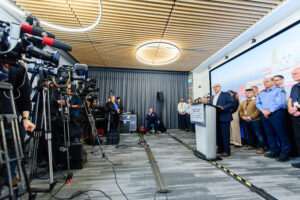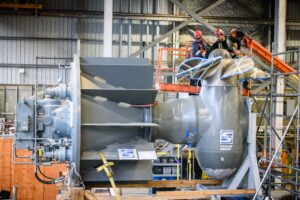- Reaction score
- 8,269
- Points
- 1,160
And TB/GoC apathy will ensure that the RCN is never an employer of choice...
Something to do with the civvy's free time being the civvy's free time perhaps?

And TB/GoC apathy will ensure that the RCN is never an employer of choice...
Canada really need a proper Royal Canadian Fleet Auxiliary, a more sustainable model than Fleet Services.
P.S.: If Canada had bought Asterix right up front and gone with that model for crewing, we probably would have broken even by now, or even be in positive cash flow.
And TB/GoC apathy will ensure that the RCN is never an employer of choice...
:quality(70)/cloudfront-us-east-1.images.arcpublishing.com/archetype/VBL7YJ4WPBHRPM2SZ7DNILR77Y.jpg)
I suspect that simple things like compensation for irregular/erratic schedules, and the ability to "opt out" of tasking/sails would help for RCN sailors.Something to do with the civvy's free time being the civvy's free time perhaps?
I knew we had those guys, I took care of the old Black Duck who came to our Museum in their colours and worked with them a number of times during my CCG career. But I didn't realize they had operated the larger vessels. The nice thing about expanding that service is you might catch some of the people who are leaving and retain some of the their skills, training and corporate knowledge.We already have that, It's called Canadian Forces Auxiliary Vessels' service. And they used to operate ships that were bigger than the tugs and harbour ferries. They used to operate the research and hydrographic vessels (Quest, Endeavour, Sackville, etc.). The structure is still there and expanding it to take in the support ships would be fairly easy.
P.S.: If Canada had bought Asterix right up front and gone with that model for crewing, we probably would have broken even by now, or even be in positive cash flow.
Why wait for the first JSS? Just threw away the Hawks with zero to backfill......just go to the Americans.I can very well see Asterix being sent on its way when JSS1 becomes operational. The lease for Asterix is costing the RCN a lot of money and we don't exactly have a lot of money right now.
The Hawks were never, ever RCAF aircraft. We did not “throw them away”. The contract was over: the contractor removed them from service.Why wait for the first JSS? Just threw away the Hawks with zero to backfill......just go to the Americans.
PS I the love reasoning. The Hawks are over 20 years old......so we have to send the pilot trainees to the States to learn on the T-38. How old are the T-38's, asking for a friend?......
I was using short hand. But as a business person I guaranty you the option to renew or extend was available. The contractor removed from service as they won't get paid for the work. This whole thing is just government messaging so they have some cover. It not like they have another customer beating down their door for them. They will go somewhere if true the contractor owns them. But is not easy transferring that type equipment. Dollars to donuts they go sit somewhere till parted out or scrapped.The Hawks were never, ever RCAF aircraft. We did not “throw them away”. The contract was over: the contractor removed them from service.
Why is this so hard to understand?
Out Out/Out In, doesn't particularly matter to me. Giving people some sense of control over their careers/life would go a long way toward alleviating some of the issues the CAF currently faces.Is there a proposed model for “opting out”?
I mean during the Cold War, I remember lads on the steamers in Esquimalt saying the B.C. Ferry to the mainland was the only boat they would be boarding if there was a shooting war. That’s one form of “opt out”.
Perhaps a system of “opting in” is better? I don’t know.
But as a business person I guaranty you the option to renew or extend was available.
The contractor removed from service as they won't get paid for the work.
You and your pesky terms and conditions…Guarantee? Are you willing to underwrite that statement?
Perhaps a re-read of the SACC Manual to review how contracts work with the GoC is in order?
Your statement seems to imply that the contractor would have kept supporting the activity were it not for the government no longer paying for the work. There are other Ts and Cs in the contract other than the Basis of Payment, and specifically the Period of Performance defined in the contract is what determines when the provision of the service has run its course.
The T38 is being replaced by the T-7.Why wait for the first JSS? Just threw away the Hawks with zero to backfill......just go to the Americans.
PS I the love reasoning. The Hawks are over 20 years old......so we have to send the pilot trainees to the States to learn on the T-38. How old are the T-38's, asking for a friend?......
Yes but it will be years. And the T38 was mentioned. Boeing not having a good time right now and the T-7 is one of the headaches. Fixed price and all.The T38 is being replaced by the T-7.



theyre doing so well on the JSS2 HMCS Preserver they should just continue on with no 3 HMCS ProviderHere is the latest update on the AOR in an update from Seaspan:
Seaspan Shipyards Q1 Update: Ready To Go
April 19, 2024
We always say that it was a busy start to the year, but 2024 surely takes the cake. Between engine cutouts, contract awards, subs being repaired and blocks being built, the Seaspan Shipyards teams in Victoria and North Vancouver came back from the holiday break ready to go.
Vancouver Drydock
It was an action-packed start to the year over at Vancouver Drydock, with a major refit project well underway in addition to the typical varied array of repair projects.
In early January the team the team waved goodbye to two Alaska Marine Lines barges, the Bering Trader and Tongass Provider after completing blast, paint and minor steel repair work. We also welcomed BC Ferries’ Northern Adventure which underwent blast and paint work, mechanical repairs, and had its propeller blades replaced during its stay between Feb 13 and March 5.
Other notable progress includes work on CCGS Sir Wilfrid Laurier which was drydocked Careen as part of an ongoing refit. Painting work on the Canadian Coast Guard vessel is well underway, and as of March 16, all three of the replacement 42-tonne engines were put back in place, with the cut-out of the hull fully welded into place the first week of April.
Meanwhile in the Panamax, three vessels are scheduled to be drydocked simultaneously between March 18 and April 1 for blast and paint work: ITB Vancouver, an oil barge which will also undergo some minor steel repairs; the Hannah, a 400ft long floating salmon processing plant owned by Northline Seafoods; and the Sunderoey, a fishing vessel which is also stopping by for a regulatory five-year inspection.
This first quarter also marked the official start of construction on a new Operations Centre Building which will enable the drydock team to move from temporary trailers and into a two-story building as they look ahead to prepare for the planned drydock expansion project.
Victoria Shipyards
In Victoria, on the VISSC program, HMCS Victoria’s Extended Docking Work Period (EDWP) is underway – the team at Victoria Shipyards is moving into the heavy production phase of the EDWP, as planned, and will be ramping up to full production over the coming months. The current priority there is steel repair.
On the Navy’s frigates, work on HMCS Calgary continues and will be ongoing through the remainder of the year. The frigates are now approaching their design end of time, and the work Victoria Shipyards is doing on the West Coast frigates will help to extend the lifespan of these platforms through to the arrival of the Canadian Service Combatants. HMCS Calgary is preparing for a final drydock period, as part of this refit, starting in May 2024 for about 6 weeks where the underwater hull will be painted, and as we complete areas of steel work, we are starting to put compartments back together in anticipation of the refit end.
Vancouver Shipyards

At Vancouver Shipyards, two NSS announcements kicked off the year. In February, we announced the completion of the ‘Prototype Block’ for the Canadian Coast Guard’s Polar Icebreaker program. Construction of this Prototype Block ensures that Seaspan has the proper processes, procedures, equipment, and skills necessary to build the first heavy Polar Icebreaker in Canada in more than 60 years. Then, in March, it was announced that Seaspan had been awarded the Construction Engineering (CE) and Long Lead Items (LLI) contracts for the pre-construction work of the Canadian Coast Guard’s first six Multi-Purpose Vessels (MPV).
Regarding our biggest ship out in the yard, HMCS Protecteur, we continue to work towards the vessel’s launch in North Vancouver by the end of the year. Ahead of launch we’re working on key mission spaces such as the laying the Helicopter Handling Tracks and finalizing the shaft alignment. To date, we’ve installed 50% of the cable, and more than 70% of the piping has been installed. Construction on the second Joint Support Ship (JSS), the Royal Canadian Navy’s HMCS Preserver, also continued at a steady rate through the first few months of the year. Being the second vessel in its class, this ship is benefiting from high levels of design maturity and efficiencies – more than 50% of the ship’s blocks are now in production, with particular focus being put on key blocks for the Engine and Pump Rooms. Shortly after the holiday break, Vancouver Shipyards received JJS2’s Bulbous Bow from local supplier Ideal Welders – the 17m long block was delivered to the shipyard via barge, and will be connected up with the rest of the hull later in 2024.

The Canadian Coast Guard’s Offshore Oceanographic Science Vessel, another one of the ships currently under construction at Vancouver Shipyards, is progressing well towards its launch date late this summer. Our expert team of engineers and skilled tradespeople are prioritizing critical areas of the ships’ final construction phase in order to ensure that everything remains on track. Electrical cabling is nearing completion and just a handful of major installations are left now that the structure of the vessel itself is complete; the Azipod thrusters were delivered to the shipyard and will be installed on the ship in late May, and the drop keel installation will be completed by the end of June. Systems and power testing will also begin in Q2, and continue through to Sea Trials later this year.
Seaspan Shipyards Q1 Update: Ready To Go - Seaspan
Long lead items would like a few thousand words.theyre doing so well on the JSS2 HMCS Preserver they should just continue on with no 3 HMCS Provider
I was just there last night, crawling around the Wilfrid Lauier doing a fire watch. They plan to launch her very soon, although there will still be a lot of internal work to be done prior to her sailing.Here is the latest update on the AOR in an update from Seaspan:
Seaspan Shipyards Q1 Update: Ready To Go
April 19, 2024
We always say that it was a busy start to the year, but 2024 surely takes the cake. Between engine cutouts, contract awards, subs being repaired and blocks being built, the Seaspan Shipyards teams in Victoria and North Vancouver came back from the holiday break ready to go.
Vancouver Drydock
It was an action-packed start to the year over at Vancouver Drydock, with a major refit project well underway in addition to the typical varied array of repair projects.
In early January the team the team waved goodbye to two Alaska Marine Lines barges, the Bering Trader and Tongass Provider after completing blast, paint and minor steel repair work. We also welcomed BC Ferries’ Northern Adventure which underwent blast and paint work, mechanical repairs, and had its propeller blades replaced during its stay between Feb 13 and March 5.
Other notable progress includes work on CCGS Sir Wilfrid Laurier which was drydocked Careen as part of an ongoing refit. Painting work on the Canadian Coast Guard vessel is well underway, and as of March 16, all three of the replacement 42-tonne engines were put back in place, with the cut-out of the hull fully welded into place the first week of April.
Meanwhile in the Panamax, three vessels are scheduled to be drydocked simultaneously between March 18 and April 1 for blast and paint work: ITB Vancouver, an oil barge which will also undergo some minor steel repairs; the Hannah, a 400ft long floating salmon processing plant owned by Northline Seafoods; and the Sunderoey, a fishing vessel which is also stopping by for a regulatory five-year inspection.
This first quarter also marked the official start of construction on a new Operations Centre Building which will enable the drydock team to move from temporary trailers and into a two-story building as they look ahead to prepare for the planned drydock expansion project.
Victoria Shipyards
In Victoria, on the VISSC program, HMCS Victoria’s Extended Docking Work Period (EDWP) is underway – the team at Victoria Shipyards is moving into the heavy production phase of the EDWP, as planned, and will be ramping up to full production over the coming months. The current priority there is steel repair.
On the Navy’s frigates, work on HMCS Calgary continues and will be ongoing through the remainder of the year. The frigates are now approaching their design end of time, and the work Victoria Shipyards is doing on the West Coast frigates will help to extend the lifespan of these platforms through to the arrival of the Canadian Service Combatants. HMCS Calgary is preparing for a final drydock period, as part of this refit, starting in May 2024 for about 6 weeks where the underwater hull will be painted, and as we complete areas of steel work, we are starting to put compartments back together in anticipation of the refit end.
Vancouver Shipyards

At Vancouver Shipyards, two NSS announcements kicked off the year. In February, we announced the completion of the ‘Prototype Block’ for the Canadian Coast Guard’s Polar Icebreaker program. Construction of this Prototype Block ensures that Seaspan has the proper processes, procedures, equipment, and skills necessary to build the first heavy Polar Icebreaker in Canada in more than 60 years. Then, in March, it was announced that Seaspan had been awarded the Construction Engineering (CE) and Long Lead Items (LLI) contracts for the pre-construction work of the Canadian Coast Guard’s first six Multi-Purpose Vessels (MPV).
Regarding our biggest ship out in the yard, HMCS Protecteur, we continue to work towards the vessel’s launch in North Vancouver by the end of the year. Ahead of launch we’re working on key mission spaces such as the laying the Helicopter Handling Tracks and finalizing the shaft alignment. To date, we’ve installed 50% of the cable, and more than 70% of the piping has been installed. Construction on the second Joint Support Ship (JSS), the Royal Canadian Navy’s HMCS Preserver, also continued at a steady rate through the first few months of the year. Being the second vessel in its class, this ship is benefiting from high levels of design maturity and efficiencies – more than 50% of the ship’s blocks are now in production, with particular focus being put on key blocks for the Engine and Pump Rooms. Shortly after the holiday break, Vancouver Shipyards received JJS2’s Bulbous Bow from local supplier Ideal Welders – the 17m long block was delivered to the shipyard via barge, and will be connected up with the rest of the hull later in 2024.

The Canadian Coast Guard’s Offshore Oceanographic Science Vessel, another one of the ships currently under construction at Vancouver Shipyards, is progressing well towards its launch date late this summer. Our expert team of engineers and skilled tradespeople are prioritizing critical areas of the ships’ final construction phase in order to ensure that everything remains on track. Electrical cabling is nearing completion and just a handful of major installations are left now that the structure of the vessel itself is complete; the Azipod thrusters were delivered to the shipyard and will be installed on the ship in late May, and the drop keel installation will be completed by the end of June. Systems and power testing will also begin in Q2, and continue through to Sea Trials later this year.
Seaspan Shipyards Q1 Update: Ready To Go - Seaspan
